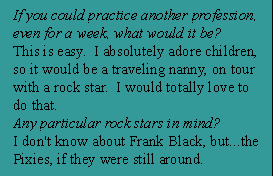 The Online Magazine about New York Designers |
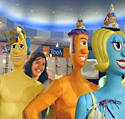 click for larger images |
If you've got Bart Simpson decorating your boxer shorts, chances are Hilary Porstman is responsible. As the head designer of SaraMax's mens and boys division, this is a woman who knows underwear. Her "research" includes walking up to men in bars and asking them the big "boxers or briefs" question. (How many gals in this town can say that?) Hilary is one of the "invisible" designers essential to the Garment
District - her name doesn't appear anywhere on her designs. Working
behind the scenes, Hilary has found out a lot about body image, the
difficulties of designing with a sales mentality, and why you can't
find Krusty the Clown pajamas. LG: So you actually get paid to discuss the finer points of underwear with men you've never met? (Laughter). What's your opening line? HP: It usually starts with 3 - 4 guys at a bar [talking] about something probably far less interesting and I will generally just bust in on the conversation and start grilling them about what kind of underwear they have on right at this very moment. I figure it is my duty to find out just what the boys want -- and it's obviously the most interesting form of flirtation in existence. (Laughter) DB: How do they react? HP: It's always a hesitant initial response; however once you got them started, they will go on and on. The last time, the initial reply was "boxer briefs [fitted boxers] are always cool and the ladies like 'em." But, if you dig a bit further, they confess that although we (the ladies) like them to wear [cool updated styles], they wouldn't wear them all of the time, because they felt that a man didn't look good in them, unless he had a perfect body. The male species finally admitted out loud that they are potentially as self-conscious as we are! |
|
|
|
DB: Exactly. Does it bother you at all? HP: I think that, at points earlier, it used to bother me, but [as head of a design division], it's a different situation now.... LG: I know that when I designed for accessories companies, it didn't bother me; I was just excited about what I was doing. I was excited seeing my stuff in the stores. But then there were times that the top designers got all of the glory. HP: My work is my baby now. So, even though I work for a company, I feel that I get most of the credit. DB: Do you aspire to be on your own? To have your name on the designs? HP: I've thought about it. One idea I've had is to do a custom lingerie line. Finding lingerie for girls is tough, especially being so tall, like I am, or having a part of your body that's different. And, somewhat related to this, and to the custom lingerie thing, my boyfriend is 6' 7 " -- he's a tall guy -- I've also thought about doing men's sleepwear, for big & tall, because that's a niche market that would do very well. LG: It's hard to find things even if you have a decent, "average" sized body. What's "normal" to fashion people is quite alien to most of the country. (Laughter). HP: Even in this company -- that is,
a discount, mid-tier level [for people with real bodies] -- our showroom
standards are basically model's sizes. DB: Do you think you ever could use a more typical person, as opposed to the model figure? HP: Yeah, I think that would make more sense, in mass market. And we do try to get half of the garments on our sales person as well to get a real sense of fit. LG: You're talking about mainstream stores in America, and the people who shop there are not model bodies, so you're not designing for a store in NoLIta.... HP: We have something called "hanger appeal." Even at the [mass market] level, they care about how the clothes are going to hang on the rack; so, they're going to show you a boxer that's much smaller, because it looks better and you'll buy it. You don't want to actually know you're that big. |
|
|
|
LG: And, it's ironic that men have become just as vain, as you were saying earlier. I always thought it would be great when women finally stopped obsessing about their bodies and had more of the attitude that men did, but what's happened is the reverse. HP: I've seen a switch in the trends, where men are more self-conscious; I see this in a lot of trend sites, and there's one in particular which is constantly talking about men, and grooming products, and things along that line. LG: What percentage of your work is licensed products? HP: That's probably what the company is known for. I used to do a lot of Disney -- Winnie the Pooh, and Mickey, mostly. Now I do Simpsons and a few others. LG: What's your favorite character? Or, is your favorite the non-licensed designs? HP: I like the non-licensed. I like not having as many restrictions, rather than: "you have to do this, and you have to use this character." So, my favorite is doing Private Label for the smaller accounts. For example: Right now I'm working on a program for a skate/ surf shop chain that's really going to be terrific. We're working on great old vintage plaids that Grandpa used to wear. LG: But getting back to licensing for a second, when you are working on Simpsons boxers, do you have a lot of freedom about which characters you can use? HP: It depends on what sells. For men, there are a lot of things with Homer and Marge together, because they're funny together. You don't see Maggie on the men's product ever. And Krusty sometimes. LG: I love Krusty! HP: It's funny, because the side characters are probably what would sell more. DB: I'm kind of partial to Sideshow Bob. LG: I want a Sideshow Bob camisole (Laughter). Or the aliens. HP: There's something like two hundred characters in
that show, and th LG: That's ironic, since the show itself has so much merchandised "Krusty" product. It's all over Bart's room. And those products are great; everyone I know wishes those existed! HP: But the buyers don't believe that. So, you're stuck; that's the thing. The buyer thinks it's too risky. The last time I designed for "Simpsons," I did three-quarters of it Krusty [themed] and about one-quarter of it, Bart and Homer, but the buyers didn't like it. LG: But Bart and Homer have been around a really long time; don't people want something new? HP: They don't think it will sell. And, if they would just try it just a little bit - two or three boxers out of six... LG: So what will they try? What's mainstream and what's "edgy?" Do you think that the stuff that was considered "edgy" has become more mainstream, because of catalogs like Delia's, and MTV exposure and being able to order it on the internet? I think that trends get really saturated now. HP: There's a section within Magic [a major industry trade show in Las Vegas] called "the Edge," which is all tattoos, goth, tie-dyes. Anything that doesn't fit into the mainstream sportswear area, is over there. It's very funny; they think it's so edgy [at this show], but really, it's often not. LG: It's already out there it's mass catalog. When I worked in the fashion biz, it was pre-MTV and pre-Internet; it was very different. Trends would take a lot longer to translate across the country. It was always Europe first -- Paris and Milan -- and then New York would get the trends, and then about a year later, things would start to filter down to California, then Dallas and Miami. It took a while. I remember how New York designers were really smug, back in the early '80's, where we felt that we were finding these things out first, way, way before anyone else, and we'd be wearing it for at least a year, before anyone elsewhere would wear it, and of course, then we would see the trend continue for years, and get impossibly sick of it (laughter), and wish it would go away already. HP: It's funny how a trend will happen in New York, and everyone will just eventually catch on and start wearing it, even if it's not something that's good [that they like]. Like the blouson tops from the '70's or, as I saw just the other day at H&M, the pants that are gathered on the knees -- knickers -- that were on "Sex and the City." I know that people are going to start wearing that now, and I think to myself, "I'll never wear that." DB: And on the other hand, part of your job has been that trend forecasting, and you have to sortof push those trends out the door. So, in a way, you're on both sides of it. HP: I push the ones that I like! (Laughter). LG: But, that's good! You get to filter a bit. DB: So, do you think being in New York helps or hinders your work? HP: I don't know if there is a negative; honestly. The
only thing that comes up when I think of my career is that, when I went
into design I very much loved it, but I was also afraid of it, because
I know that the garment industry is competi LG: That was the same reason that I had gone into accessory design. I felt that it was a little bit less competitive. I thought, "oh, I can't possibly deal with doing clothes; I can't deal with that world." HP: I hate to stereotype it, but there is some truth to it. I couldn't stand a lot of the people I met in school at FIT, because it was a constant fashion show, and they were always strutting their stuff walking down 27th street. To me, if you're working really hard, you haven't gotten any sleep, and so, you haven't had time to look that good (laughter). You're too busy, working on projects; it's not realistic. LG: At Parsons, it was very similar. DB: Lori, you told me that there was actually a dress code at Parsons when you were there... LG: There was an unwritten code at the fashion department, years ago. Women were told that they could not wear pants unless they were a size 8 or under. The fashion director at the time would tell us that women "looked like cows," in pants, unless they were under a size 8. HP: Whaaaat? LG: Yes, it was insane; it made me furious. And, the men had to keep a jacket and tie in their lockers at all times, and jeans were discouraged. They said that it was because designers, critics and patrons were always coming through the building. That was one of the main reasons I dropped out of the department; I couldn't continue with certain things on principle. Even though, in their minds, they felt "we're preparing you for Seventh Avenue, and if you think this is tough, well, you haven't really seen anything yet." DB: So, let's talk about when you first got to New York from Delaware. How did you react? HP: Well, I came here to study at FIT and it was an accelerated program, so I was doing two years in one. I didn't even know what New York looked like until I graduated. I had no idea. I was working constantly. I think that the extent of it in those first nine months was Washington Square Park, and maybe a five block radius. I didn't have time to go exploring and it was all so overwhelming to me. LG: How about now? You've been here five or six years.. HP: There's points where you just get sick of being in New York, and you think, "Let me get out of here for a while." DB: But, where else could you go, to be a fashion person?
HP: My only avenue would be California, maybe San Francisco. LG: It's a totally different fashion design scene over there. HP: Yeah. But, I get sick of New York [sometimes]; everybody wears black, everybody looks alike... DB: But, many people say that when they leave New York, everybody looks alike, and it's not as diverse elsewhere... LG: I find that I get really impatient when I am outside of New York. HP: Oh, definitely. And I find myself to be slightly jaded in the last couple of years. LG: Yay, we're corrupting you! (Laughter) DB: OK, I have a New York question: what's your favorite subway line? HP: The F train from midtown to Brooklyn; I like studying the people and what they're wearing. LG: And, what's your favorite subway station? HG: Well, my least favorite is the 2nd avenue stop, off the F line. I always go out in the East Village, and I always end up at that subway station, when you just want to be home at 3:00 in the morning. DB: That's our station. Be glad you weren't using it 10 years ago; it was pretty bad. So, you don't have a favorite station? HP: No, I hate waiting. I just want to be on the train. DB: So, you ARE becoming a New Yorker (laughter).
|
|

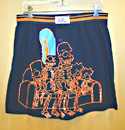
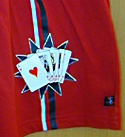
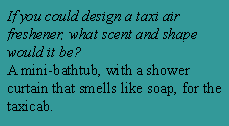 HP: Oz, behind the curtain.
HP: Oz, behind the curtain. 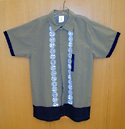
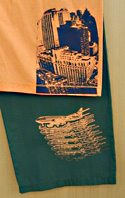
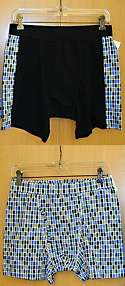
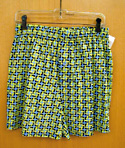
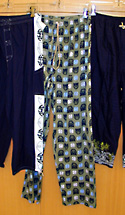
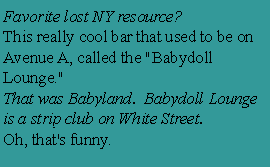 e
only ones that sell are Homer and Bart. And it stinks, because Krusty
and Sideshow Bob are great. Plus a whole mess of others that would be
fantastic if the buyers would give them a shot!
e
only ones that sell are Homer and Bart. And it stinks, because Krusty
and Sideshow Bob are great. Plus a whole mess of others that would be
fantastic if the buyers would give them a shot! 